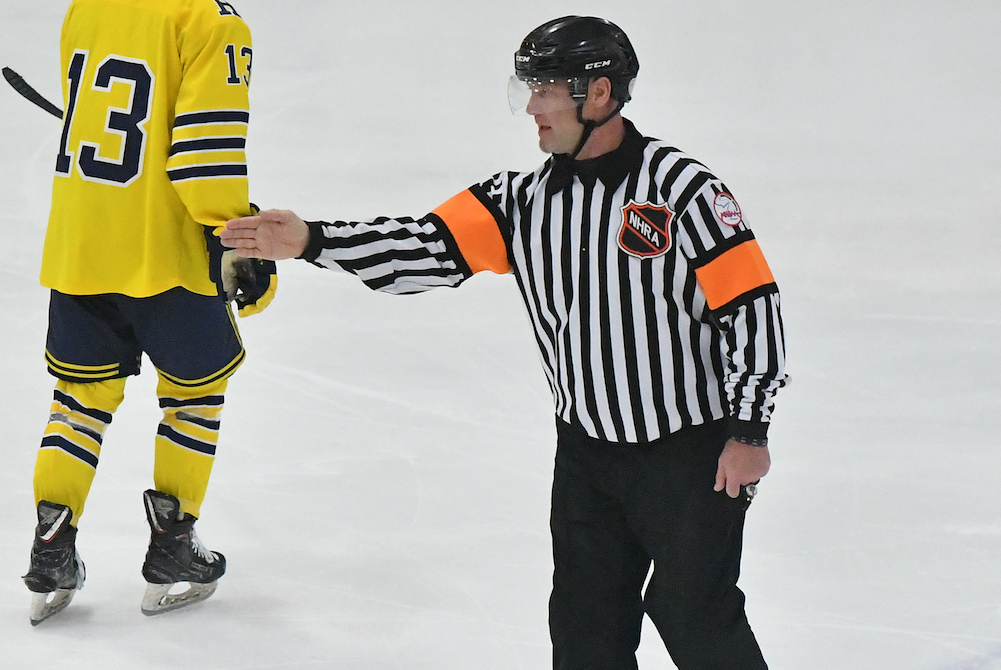
Retired NHL-er Back on Ice to Answer Call - By Making Them
By
Rob Kaminski
MHSAA benchmarks editor
March 16, 2023
The most accomplished skater on the ice during Friday’s triple-overtime MHSAA Division 1 Semifinal hockey thriller between Hartland and Brighton was not wearing the school colors of either team.
In front of a packed house at Plymouth’s USA Hockey Arena, referee Bryan Smolinski was in stripes, just like the rest of his officiating crew.
In his former life, he pulled on plenty of sweaters before lacing up the skates. That happens when one logs more than 1,000 games, tallies nearly 300 goals (274) and close to 400 assists (377) with eight teams spanning a 15-year playing career in the National Hockey League.
So, how did the 52-year-old former star player find himself on the ice last weekend as one of the referees for the pinnacle weekend of this high school season? Good question, even for the man known as “Smoke” during his playing days.
“I was working in youth development programs a few years back and reached out to some Michigan guys I had connections with about other ways to help the game,” Smolinski said. “I called Kevin May just to chat and asked, ‘Hey, how’s your reffing going?’ He said, ‘You know, we’re down a little bit,’ then said, ‘Why don’t you do it?’ I said, ‘Not a chance,’” Smolinski laughed.
Never Say Never
May persisted, imploring his friend to skate with him during a Fall league at Cranbrook in Bloomfield Hills. After eight weeks, once a week, Smolinski had a revelation.
“I’m like, ‘I’m kind of diggin’ this,’” Smolinski said “So, I did all the testing, and the educational part of it, and I really enjoyed it. I got with Danny (DiCristofaro) and his group, and he put me in as much as he could, and I really started to get my feet wet.”
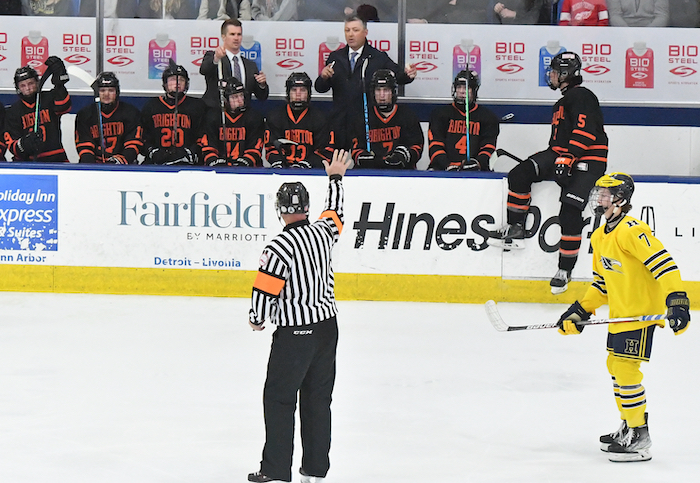 DiCristofaro is the assigner and referee-in-chief for the MHSAA’s Northeast Hockey Referees Association, and he has seen Smolinski’s growth first-hand.
DiCristofaro is the assigner and referee-in-chief for the MHSAA’s Northeast Hockey Referees Association, and he has seen Smolinski’s growth first-hand.
“Obviously he’s got great instincts and a feel for the game, along with a wealth of experience, all of which has allowed him to climb the ladder quickly,” said DiCristofaro. “It’s been a joy to watch his growth as an official.”
Fast forward to last Friday, and there were Smolinski and May sharing duties as referees during the MHSAA Semifinal with linesmen Michael Andrews and Thomas Robbins.
In between, there has been a learning curve that still continues, but the jump to officiating was not quite as daunting as his introduction to the NHL.
“I was scared to death. My first game was against Mario Lemieux. I’m in the old Boston Garden and now I’m playing against these guys and it’s their job, and they’re out there trying to make a living,” Smolinski recalled.
The emotions were not running nearly as frenzied for his first game as an MHSAA official, obviously, yet respect came in a different form.
“I couldn’t pick the puck up, I was breathing heavily; it was Kevin and me doing a two-man game in Brighton,” Smolinski recalled. “There were a few high-end kids playing, and I’m thinking, ‘I’m dying here.’ You know, there’s no training for that first time.”
What that experience did, however, was revitalize Smolinski in a new way. His playing career is well documented, not only in the NHL, but around Michigan. He enjoyed an honor-laden career at Michigan State University from 1989-93 before joining the Boston Bruins (who had drafted him three years earlier) at the end of the ’93 NHL campaign. Even after his final season, with Montreal in 2007-08, he stayed in the game via men’s leagues, or coaching his son, Max.
Smolinski and his wife, Julie, have three daughters: Ashtyn (22), Jojo (16) and Rylen (12), along with Max, whom dad coached for seven years including during a national championship run with a Little Caesars U15 team in 2019. Max, 19, is now playing collegiately at Rensselaer Polytechnic Institute.
So, for Smolinski, officiating offers a new chapter.
“Reffing brought back ... I wouldn’t say love of the game, because that’s always been there; it’s a different side of enjoying the game now. I have no horse in the race, my son’s off to college, my daughters are doing their thing; I wanted to find something new in the game,” Smolinski said. “I’ve coached, and I don’t want to do that. I found this, and I’ve stuck with it.”
Old College Ties
One of the great benefits of athletics at any level are the friendships made. For two kids who met in their first years on the MSU campus and forged a bond that lasts to this day, it’s amazing how their careers reached the pinnacle and have now come full circle.
Wes McCauley, an MSU teammate, is one of Smolinski’s best friends. After numerous years in the minor leagues, McCauley, like his friend, made it to the NHL. But McCauley made it as an official, working his first NHL game in 2003, when Smolinski was nearing the end of his playing career.
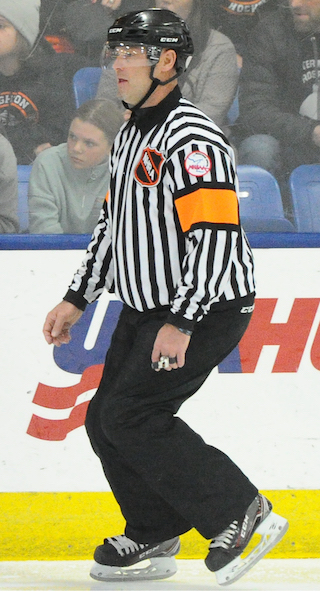 Their games lined up on just a few occasions in the NHL, and the two lobbied hard to have McCauley work Smolinski’s 1,000th career game in his final season with the Canadiens in 2007-08. The request, sadly, was denied by the league.
Their games lined up on just a few occasions in the NHL, and the two lobbied hard to have McCauley work Smolinski’s 1,000th career game in his final season with the Canadiens in 2007-08. The request, sadly, was denied by the league.
On the rare occasions when the friends did share the same ice, less than a handful by Smolinski’s count, it was McCauley who was forced to rebuff any attempts at fraternization. It’s just part of an official’s edict.
“For both of us, it was amazing; it was just great,” Smolinski said. “I’d say, ‘Hey man what’s up?’ and he says, ‘Can’t talk.’ I’m like, ‘What do you mean, we talk all the time.’ Again, he’s like, ‘Can’t talk, get away from me.’ You know, it was just business.”
McCauley then reached the 1,000-game plateau himself in 2018 and is still going strong as a regular selection for playoff duties with nine Stanley Cup Finals assignments, including last year.
So, it should have been natural for Smolinski to go to his old friend immediately for officiating pointers once he joined the ranks, right? Well, maybe not immediately.
“I talk to Wes all the time, but I actually hid it from him right out of the gate because I didn’t want to take his razzing. Eventually it got out, and he was loving it. He started sending me whistles and visors and pants,” Smolinski said, grinning. “And none of it fit, you know, because I’m older and fatter, and he’s so damn skinny. So, I still had to go out and get all new gear.”
Both Sides Now
Having been to the top of his profession, now moving to the other side of that same mountain that his friend McCauley scaled, the respect has grown for those blowing the whistle.
“The preparation for officiating is much more mental,” Smolinski said. “Way more rules oriented. You’re always trying to get away with things that you can as a player; now you have to police that.”
Smolinski has a distinct advantage.
“I know everything they’re trying to do because I’ve done it. I know where you’re going with the puck, I know what kind of breakout you’re trying to do,” Smolinski said. “I have all the instincts, now I just try to stay out of the way and not ruin their game. The most fun is watching the game develop and the ups and downs. For me to be out there and enjoy it with them, that’s the fun part.”
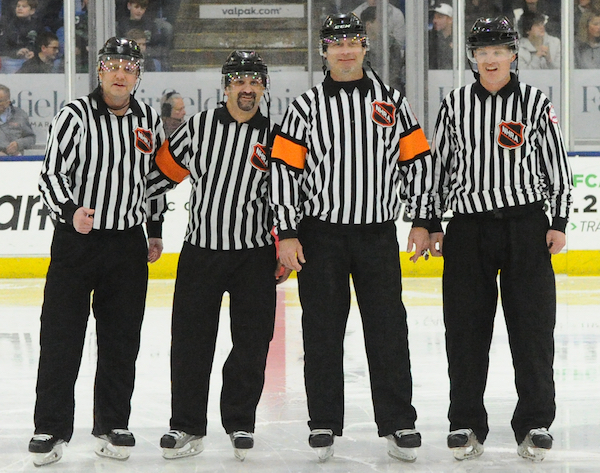 Those who have played hockey at any level have a built-in advantage should they consider the officiating avocation: the ability to skate. Unlike officiating in any other sport, skating is a prerequisite. This makes the pool limited, and almost solely composed of former players. Smolinski offers this advice.
Those who have played hockey at any level have a built-in advantage should they consider the officiating avocation: the ability to skate. Unlike officiating in any other sport, skating is a prerequisite. This makes the pool limited, and almost solely composed of former players. Smolinski offers this advice.
“I prefer sticking with high school because I think there’s more decorum, more administrative structure. Kids are playing for their schools, there’s loyalty there,” said Smolinski. “And there is more accountability. People need report to athletic directors and supervisors. Other levels can be more loosely governed, or a bit more maverick in nature. Moms and dads get involved more, coaches maybe know a little less,” said Smolinski.
He has, in fact, worked a handful of non-school games, and there’s a stark difference.
“I wanted to see what was going on, and I see it first-hand,” Smolinski said. “There are some crazy people and parents out there, and these guys are getting absolutely tortured. I’ve been tortured. There has to be a level of respect for what officials do. I think schools can rein that in a little more. All the guys I’ve met give up a lot of time and work hard because they love to do it and love the game.”
All sports need an assist from school administration and from those who once played the games to keep the officials recruitment moving in the right direction. People like Smolinski can help.
“He clearly doesn’t need to do this, and that’s what makes it so fantastic,” DiCristofaro said. “We need more people who have played – at any level – to do what he’s done and stay in the game as officials.”
Smolinski continues to promote the game in other ways as well. Currently, he is involved in the NHL’s Learn To Play initiative, which aims to inspire youth and welcome more families into the hockey community.
“We work hand-in-hand with the NHL Players Association for player development and industry growth,” Smolinski said. “Ages 5 to 9 are introduced to hockey, get head-to-toe gear and instruction, and meet some former players.”
The idea is to have fun first, which can translate into years and maybe even a lifetime in the sport. It’s a lifetime that has given Smolinski so much and continues to do so as he watches it unfold for others from his new vantage point.
PHOTOS (Top) MHSAA official Bryan Smolinski signals during Friday's Division 1 Semifinal between Brighton and Hartland. (2) Smolinski, a retired NHL standout, communicates with the Bulldogs' bench. (3) Smolinski keeps watch during game play. (4) Smolinski, third from left, with his crew: Michael Andrews, Kevin May and Thomas Robbins.
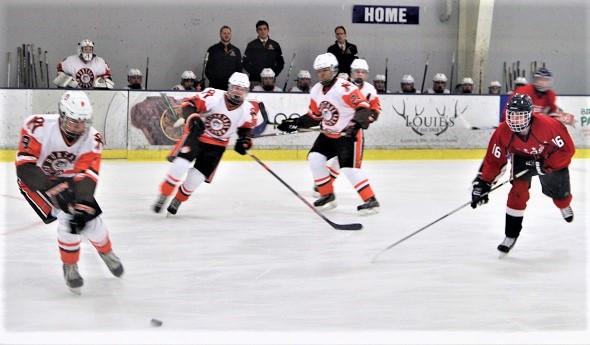
CAAC, SW Teams Find Home in New League
By
Pam Shebest
Special for MHSAA.com
January 21, 2020
Two struggling hockey leagues found a perfect match, thanks to the behind-the-scenes work of commissioners, athletic directors and coaches.
 The Capital Area Activities Conference, a multi-sport league, had just four hockey teams.
The Capital Area Activities Conference, a multi-sport league, had just four hockey teams.
The Southwest Michigan High School Hockey League was down to five.
Merging the two leagues was a no-brainer for all involved.
“We learned (the CAAC) was a small league like us,” Portage Northern athletic director Chris Riker said. “It’s tough to have a league with just five teams. By putting our two leagues together, and we had already played a lot of those teams, it just made a lot of sense.”
The new 10-team league, called the South Central High School Hockey League, is bringing a new excitement to both areas and came together very smoothly in less than a year.
Forming a new league boiled down to one thing: “survive and thrive,” said Randy Allen, a former MHSAA assistant director and retired CAAC commissioner.
“I’m tickled pink, and I give high marks to the coaches and athletic directors.”
The league is divided into the Central and South divisions, with five teams in each.
Most teams in the league are co-op teams with Jackson Lumen Christi in the Central and Mattawan, Portage Central and Portage Northern in the South the only teams made up of students from one school.
Other teams in the Central Division are the Capital City Capitals (DeWitt, Lansing Catholic, Mason, St. Johns), Mid-Michigan Marauders (Holt, Grand Ledge, Eaton Rapids, Portland, Potterville), East Side Stars (East Lansing, Williamston, Haslett, Bath, Laingsburg) and Okemos (with Fowlerville).
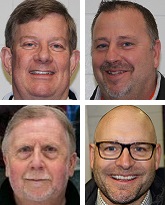 Co-op teams in the South are the Kalamazoo Eagles (Gull Lake, Battle Creek Harper Creek, Battle Creek Pennfield, Paw Paw, Parchment, Plainwell) and Kalamazoo United (Loy Norrix, Kalamazoo Central, Hackett Catholic Prep).
Co-op teams in the South are the Kalamazoo Eagles (Gull Lake, Battle Creek Harper Creek, Battle Creek Pennfield, Paw Paw, Parchment, Plainwell) and Kalamazoo United (Loy Norrix, Kalamazoo Central, Hackett Catholic Prep).
The first big showcase event featuring all 10 teams is set for Friday and Saturday at Wings West in Kalamazoo.
“One of the other cool things about this new league is we’re bringing them all together for the ‘Annual Youth Hockey Fights for Autism’ at Wings West Feb. 15, and all 10 teams will be playing,” said Frank Noonan, commissioner of the old SWMHSHL and now commissioner of the new league.
Riker said the new league “creates some excitement the way we structured the season with playing in your division and playing crossover games.
“We’re going to have a big championship game where the two No. 1 teams play each other, the second-place teams meet and so on (Feb. 22 at Wings West).”
There are other benefits as well, Noonan said.
“The best thing for hockey in the area is they have set opponents they’re going to play every year and, for the kids who earn (end-of-season) awards, it means more,” he said.
“There are 10 teams competing for the awards rather than our typical six-team old division, so it’s more prestigious, more of an honor to win an award in the new league.”
MHSAA Assistant Director Cody Inglis, who took over administration of hockey for the Association when Allen retired in 2014, put Riker – a member of the MHSAA’s Representative Council – in touch with Allen. The two jump-started talks last March.
One key was getting the Eagles to become a school-based team rather than a club one.
“Karyn Furlong (Gull Lake athletic director) was willing to jump on and sponsor the Eagles,” Riker said. “She did all the leg work in getting the schools on board.
“The Eagles organization also deserves a lot of recognition for saying, hey, we’ve been in this club status and now we’re willing to come in and be a school sport.
“Now they have the opportunity to play in the state tournament, which they’ve never had.”
The MHSAA Semifinals and Finals are set for March 12-14 at USA Hockey Arena in Plymouth.
Allen, who went on to serve as commissioner of the CAAC until retiring at the start of this school year, first floated the idea of merging the two leagues to coaches from his conference.
“They were all in favor of it,” he said. “(Inglis) talked with (Riker), and we met to talk.
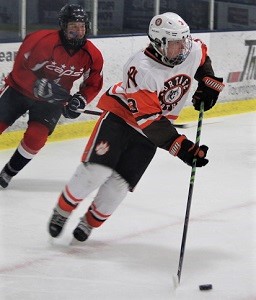 “At the athletic directors conference (in March 2019), we kept inching closer to forming a new league. We did not hear one word of objection through the entire process. We had 110-percent backing.
“At the athletic directors conference (in March 2019), we kept inching closer to forming a new league. We did not hear one word of objection through the entire process. We had 110-percent backing.
“After everybody covered all the bases, we made it final and came up with the official name.”
Allen said the new league has “great leadership from the athletic directors and (Noonan), who took the lead on everything.”
He added that one perk of the new league is getting officials together. “Now we get officials to be part of one overall group, and there is a possibility of mentoring,” Allen added.
Capital City Capitals coach Travis Van Tighem likes the new league.
“It’s great to get some more natural rivals,” he said. “Our league got to be so small we played a lot of other (non-league) teams or showcase games.
“When more games have meaning or some substance to them, you can see kids growing and there are some natural rivalries that it creates, so it’s exciting.”
Travel is not a problem, Van Tighem added.
“For us in Mid-Michigan, it you go outside the Lansing area, it’s going to be an hour anyway. So coming to Kalamazoo, it’s an hour 20 or hour 15, but if we go anywhere else, except for Jackson, it’s going to be at least an hour,” he said.
“Athletic directors and coaches got together, and it really came together nicely. It’s been great so far.”
Other league facilities besides Wings West are Optimist Ice Arena (Jackson), Summit Sports and Ice Complex (Dimondale) and Suburban Ice (East Lansing).
 Pam Shebest served as a sportswriter at the Kalamazoo Gazette from 1985-2009 after 11 years part-time with the Gazette while teaching French and English at White Pigeon High School. She can be reached at [email protected] with story ideas for Calhoun, Kalamazoo and Van Buren counties.
Pam Shebest served as a sportswriter at the Kalamazoo Gazette from 1985-2009 after 11 years part-time with the Gazette while teaching French and English at White Pigeon High School. She can be reached at [email protected] with story ideas for Calhoun, Kalamazoo and Van Buren counties.
PHOTOS: (Top) Portage Northern and Capital City face off in an SCHSHL crossover Jan. 9 at Wings West. (Middle) Clockwise from top left: Frank Noonan, Chris Riker, Travis Van Tighem and Randy Allen. (Below) Northern’s Nolan McCarthy (3) charts his next move with the puck. (Photos by Pam Shebest.)

